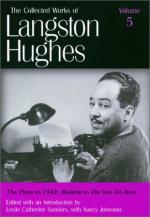|
This section contains 399 words (approx. 1 page at 400 words per page) |

|
Mulatto Summary & Study Guide Description
Mulatto Summary & Study Guide includes comprehensive information and analysis to help you understand the book. This study guide contains the following sections:
This detailed literature summary also contains Bibliography and a Free Quiz on Mulatto by Langston Hughes.
Langson Hughes's Mulatto: A Play of the Deep South, which is usually referred to by the shorter title of Mulatto, was the writer's first full-length play. Although it was not published until 1963, when it was published in Five Plays by Langston Hughes, it was written in the early 1930s and first performed on Broadway in 1935. This stage production set a record for the number of performances of a play by an African American but, nevertheless, only hurt Hughes's image. The play was produced by Martin Jones who dramatically changed the written play by adding a rape scene and other sensational elements to make it sell better on Broadway. The play was so controversial that it was banned in Philadelphia. Like many of Hughes's works, Mulatto highlights the less than desirable stereotypical qualities of African Americans of the time, such as uneducated speech. Elements like these often provoked harsh criticism of Hughes within the African American community.
Many critics cite the autobiographical elements of the play, which detail the racial conflict between a white plantation owner, Colonel Thomas Norwood, and the mulatto son Robert, whom he refuses to recognize as his own. Hughes's own father rejected him, an event that deeply affected the course of his life and the themes in his works. Some scholars believe the play was adapted from a short story by Hughes entitled "Father and Son," since Hughes noted this in some of his story notes; others believe that this is impossible, claiming that "Father and Son" was written later than the play. In any case, the play takes place at the same time it was written, in the depression-era 1930s, when most people were glad to have any form of job. For this reason, Robert's headstrong refusal to work in his father's cotton fields would have appeared even more daring to contemporary audiences. In addition to American racism, the world was also witnessing the effects of racial relations on a much grander scale as Hitler and his Nazi party attempted to wipe out the Jewish population of Europe. A current copy of Mulatto can be found in The Collected Works of Langston Hughes, Volume 5, The Plays to 1942: Mulatto to The Sun Do Move, which was published by the University of Missouri Press in 2002. One final note: readers should not confuse this play with the poem by the same name, which was written in 1926.
Read more from the Study Guide
|
This section contains 399 words (approx. 1 page at 400 words per page) |

|



